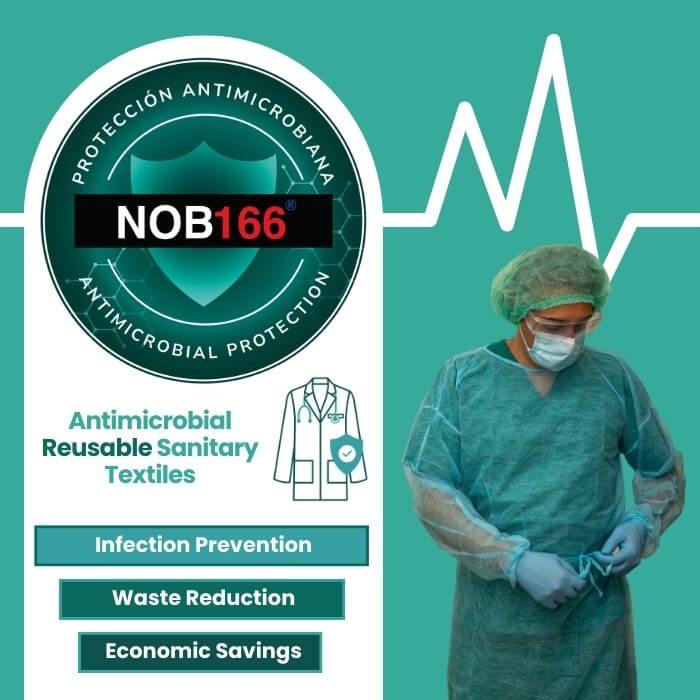
Laura Lechuga: Winner of NOB166 National Nanotechnology Award
2 de June de 2023
Dr. José Molina Orosa: first Canarian public hospital that uses NOB166
2 de December de 2024In the healthcare sector a reusable surgical gown is the best option in order to save costs and contribute to environmental sustainability by reducing waste. This last one is crucial in the decision making process. In this post we will explain de difference between disposable vs reusable surgical gowns.
We will take an in-depth look at a study carried out by the American Reusable Textile Association (ARTA) and their conclusions.

For this purpose, the manufacturing, use and end-of-life were analysed. The addition of NOB166 antimicrobial technology to textiles and medical devices plays a crucial role in preventing the proliferation of harmful microorganisms and other added benefits.
Disposable hospital patient gowns and other textiles are a frequent choice in the healthcare environment, but they have caused a serious environmental problem:
According to a study by Environmental Science & Technology, hospitals generate 3.4 billion kilos of solid waste per year. While the disposable medical supplies industry accounts for 40.3 billion dollars. This not only takes up landfill space, but also contributes to toxic gas emissions when they are incinerated. This increases global warming.
4 Advantages of a Reusable Surgical Gown
In an increasingly environmentally conscious world, this type of environmental impact reduction, reusable sterile surgical gowns, among other products, have become a cost-saving and sustainable option. These are some of the benefits obtained in the ARTA study:

Reduction of Natural Energy Use by 28%
This translates into less impact on the environment and a step towards a more sustainable future. These contribute to the preservation of natural resources.
30% Decrease in Greenhouse Gas Emissions
By choosing this type of disposable surgical drapes and gowns we help to reduce greenhouse gas emissions by 30%. This is crucial to combat climate change and to keep a cleaner air.
41% Reduction in Blue Water Extraction
This type of resource is the amount of water from surface or groundwater sources that is used for the production of products or services. It is an essential resource.
93% Reduction in Solid Waste Generation.
One of the most striking advantage of using a reusable surgical gown is this overwhelming figure. This type of product reduces the amount of waste in landfills.
Reasons to Buy an Antimicrobial Surgical Gown
Infection Prevention
The WHO states that the treatment of sanitary waste can lead to indirect health risks by releasing pathogenic microorganisms and toxic contaminants into the environment.
The addition of NOB166 antimicrobial additive takes sustainability a step further as it helps prevent the spread of microorganisms. This is essential in medical environments. Not only do we contribute to improving the safety of healthcare workers, but we also protect patients by introducing it into hospital gowns and other textiles.

Long term savings
As well as being an environmentally beneficial choice, it is also a cost-saving choice due to its durability. The adoption of reusable sanitary gowns with the antimicrobial additive NOB166 not only benefits the environment, but can also be an economically smart choice. Research shows that, when managed properly, these gowns have no cost disadvantages compared to disposables.
Waste reduction
In addition to the lower cost of purchasing a new package of disposable surgical gown that is thrown away after use, less waste is generated. Textile made with NOB166 technology such as a reusable sanitary gown is designed to be more durable, significantly reducing the need for frequent replacement.
In conclusion, the results of the study carried out by the American Reusable Textile Association (ARTA) show that there is a need for a more sustainable approach in the healthcare environment. Medical care is evolving towards a greener approach, and disposable surgical gown as well as other type of textile and product of the hospital environment have a negative impact on the environment.
The transition to more eco-friendly practices is an option that reduces the environmental burden and offers added benefits.
By manufacturing products with antimicrobial properties such as the solutions offered by NOB166 Technology, we can drastically reduce the figures outlined throughout this post.
Protection is key to providing quality and safe medical care where not only the patient is protected, but also the healthcare worker who is exposed to millions of microorganisms on a daily basis. Let's remember that textiles as well as products that are found in a hospital or health centre can be vectors of contagion.
A reusable surgical gown with our additive is the solution to prevent infections, save costs and ensure protection.
